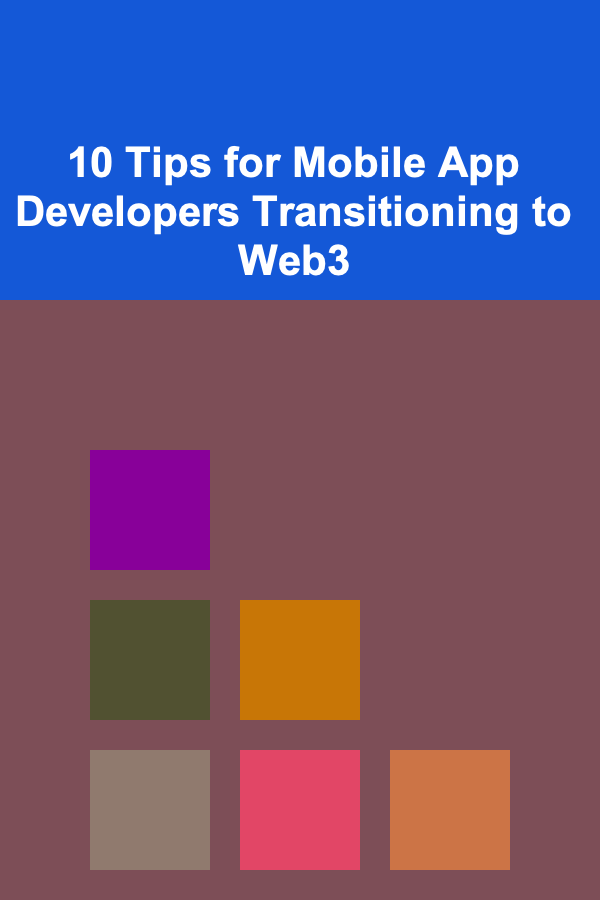
10 Tips for Mobile App Developers Transitioning to Web3
ebook include PDF & Audio bundle (Micro Guide)
$12.99$7.99
Limited Time Offer! Order within the next:

As mobile app development continues to evolve, one of the most exciting and rapidly growing areas is the transition to Web3 technology. Web3 represents a new era of the internet, where decentralization, blockchain, and smart contracts play a pivotal role in shaping how users interact with digital applications. As a mobile app developer with experience in traditional centralized applications, moving to Web3 can seem daunting, but it presents an incredible opportunity to innovate, build new experiences, and tap into the rapidly expanding Web3 ecosystem.
In this article, we'll explore 10 essential tips for mobile app developers looking to transition to Web3 development. Whether you're looking to integrate blockchain into your app, build decentralized applications (dApps), or create unique user experiences through tokenization, these tips will help you navigate the new Web3 landscape effectively.
Understand the Core Concepts of Web3
Before diving into the technicalities of Web3 development, it's important to understand the fundamental concepts behind it. Web3 is a decentralized version of the web, powered by blockchain technology. Here are some key components to familiarize yourself with:
- Blockchain: A decentralized ledger that records transactions and data securely and transparently. Popular blockchain platforms include Ethereum, Binance Smart Chain, and Solana.
- Smart Contracts: Self-executing contracts with predefined conditions, stored and executed on the blockchain. They are the backbone of most Web3 applications.
- Decentralized Applications (dApps): These are applications that run on a blockchain network rather than centralized servers.
- Cryptocurrencies and Tokens: Web3 often involves the use of cryptocurrencies for transactions or token-based economies. Tokens can represent assets, access rights, or even governance in decentralized organizations.
Understanding these concepts will give you a strong foundation to build Web3 applications. Familiarize yourself with the various blockchain ecosystems, consensus mechanisms, and token standards (such as ERC-20, ERC-721) as these will directly influence how you develop applications in Web3.
Learn Blockchain Development Tools and Languages
Once you have a solid understanding of Web3 concepts, it's time to get hands-on with the development tools and languages used to build Web3 applications. For mobile developers, some of the core tools you need to get familiar with are:
- Solidity: Solidity is the most widely used programming language for writing smart contracts, especially on the Ethereum blockchain. Learning Solidity is a must if you're developing dApps that involve smart contracts.
- Web3.js / Ethers.js: These JavaScript libraries allow developers to interact with the Ethereum blockchain from web applications. You'll need to understand how to use these libraries to integrate blockchain functionality into your apps.
- Hardhat / Truffle: These are development environments that allow you to write, test, and deploy smart contracts. They also support integrating blockchain nodes for testing purposes.
- IPFS (InterPlanetary File System): IPFS is a protocol for decentralized storage. It is commonly used to store files off-chain in Web3 applications.
- MetaMask / WalletConnect: These are browser extensions and mobile wallet protocols used to interact with Ethereum and other blockchains. Integrating them into your mobile apps allows users to manage their assets and interact with dApps.
Familiarizing yourself with these tools will give you the necessary skills to develop, test, and deploy Web3 applications.
Understand User Authentication in Web3
One of the most significant changes you'll face when transitioning from mobile app development to Web3 is user authentication. In traditional apps, user authentication is typically handled through centralized login systems like email/password combinations or social media logins. In Web3, however, authentication relies heavily on blockchain wallets.
Here are some key points to consider:
- Wallet-based Authentication: Users log in to your dApp by connecting their blockchain wallet (such as MetaMask, Trust Wallet, or Coinbase Wallet). This eliminates the need for traditional login credentials and enables decentralized identity management.
- Private Keys and Security: Blockchain wallets use private keys to sign transactions. It's essential to educate users on how to safely manage their private keys and recovery phrases to avoid losing access to their assets.
- Decentralized Identity (DID): DID is an emerging concept in Web3 that allows users to own and control their identities without relying on centralized authorities. Keep an eye on how DID can be incorporated into your applications.
As a developer, you'll need to integrate wallet connections into your app and ensure that authentication and authorization processes are seamless and secure.
Learn About Gas Fees and Transaction Costs
In the traditional mobile app world, transactions are typically free or require minimal processing costs. However, in the Web3 world, transactions often come with a cost, known as "gas fees." Gas fees are required to pay for the computational work needed to process transactions or execute smart contracts on the blockchain.
Here are a few things to consider about gas fees:
- Ethereum Gas Fees: Ethereum's gas fees can fluctuate significantly based on network congestion. It's important to implement mechanisms to inform users about the current gas prices and allow them to make informed decisions.
- Layer-2 Solutions: To mitigate high gas fees, Layer-2 solutions like Polygon, Optimism, and Arbitrum offer scaling solutions that reduce transaction costs while still utilizing the security of the Ethereum network.
- Gas Fee Estimation: Learn how to integrate gas fee estimation into your app so users can know in advance how much they'll need to pay to interact with your dApp.
Managing gas fees efficiently will help you build a better user experience and avoid bottlenecks caused by high transaction costs.
Focus on UX/UI Design for Web3
Web3 apps come with a set of unique challenges when it comes to user experience (UX) and user interface (UI) design. Many Web3 apps are still in their early stages, and the user interfaces can often be intimidating for non-technical users. As a mobile app developer transitioning to Web3, it's essential to prioritize a clean, user-friendly design that simplifies the complexity of blockchain interactions.
Some design principles to consider:
- Onboarding and Education: Provide clear onboarding processes that educate users about blockchain, cryptocurrency, wallets, and how to interact with your app. Use tooltips, tutorials, and FAQs to demystify Web3.
- Simplified Wallet Integration: Make wallet integration as seamless as possible. Avoid overcomplicating the process with multiple steps and ensure that users can easily connect their wallets to your app.
- Transaction Feedback: Blockchain transactions can take time to confirm, especially on congested networks. Provide clear feedback to users during the transaction process and give them progress indicators, so they don't feel lost.
- Mobile-First Design: Since you're transitioning from mobile app development, leverage your mobile-first expertise to create optimized experiences for mobile users.
Good design is crucial in bridging the gap between Web3 technology and mainstream users. Aim to create an interface that is simple, intuitive, and inviting.
Integrate Web3 Payments and Crypto Wallets
Web3 applications often rely on cryptocurrency payments for in-app purchases, subscriptions, and other transactions. As a mobile app developer, you'll need to integrate Web3 wallets and payment systems into your app.
Here's what to keep in mind:
- Crypto Wallets Integration: Support a variety of crypto wallets (e.g., MetaMask, Trust Wallet, Coinbase Wallet) to give users the flexibility to interact with your app. You can do this using wallet-connect libraries or APIs.
- Payment Gateways: There are decentralized payment processors and gateways like Forta or Superfluid that you can integrate into your app to accept cryptocurrency payments or subscriptions.
- Stablecoins: To avoid the volatility of cryptocurrencies, consider supporting stablecoins (such as USDT or DAI) for transactions.
Adding crypto payments gives your app a global and decentralized economic system that traditional apps can't offer.
Implement Tokenomics and Incentives
One of the most exciting features of Web3 applications is the use of tokens. Tokens can be used to incentivize users, represent ownership, or unlock certain features within your app.
Consider the following:
- Utility Tokens: Create your own utility token that can be used within your dApp. For example, tokens could be used to pay for transactions, access premium features, or participate in governance.
- NFTs (Non-Fungible Tokens): NFTs allow users to own unique digital assets such as collectibles, art, or in-game items. Consider integrating NFTs into your app as a way to reward users or create unique, limited-edition content.
- Governance Tokens: In decentralized organizations (DAOs), users can use governance tokens to participate in decision-making processes. You can integrate these tokens into your app to give users a sense of ownership and control.
Designing a solid tokenomics model will help you create a self-sustaining ecosystem and drive user engagement.
Adopt Security Best Practices
Security is a critical aspect of Web3 development. Since Web3 applications often involve users' financial assets, it's essential to ensure that your app is secure from potential attacks and vulnerabilities.
Here are some tips:
- Smart Contract Audits: Before deploying your smart contracts, have them audited by professional security firms to identify and fix any potential vulnerabilities.
- Private Key Management: Help users securely store their private keys and recovery phrases. Consider implementing hardware wallet support for added security.
- Avoid Centralized Control: The key feature of Web3 is decentralization. Ensure that your app doesn't have centralized points of failure that could compromise the security and integrity of the system.
Security should be a top priority when building Web3 applications, and failure to implement proper measures can lead to loss of assets or user trust.
Test on Multiple Networks
Since Web3 operates on decentralized blockchains, it's important to test your app across multiple blockchain networks to ensure it functions properly. Each blockchain has different characteristics in terms of transaction speeds, costs, and scalability.
- Mainnet vs Testnet: Always test your dApp on a testnet (such as Rinkeby, Kovan, or Goerli) before deploying it to the mainnet. This allows you to experiment without incurring real transaction fees or risking assets.
- Cross-Chain Compatibility: If your app will operate across multiple blockchain platforms, test it on each network to ensure interoperability.
Testing on multiple networks will help you ensure that your app is robust and works seamlessly across different environments.
Stay Updated with Web3 Innovations
The Web3 space is constantly evolving. New technologies, standards, and tools are emerging regularly, so it's important to stay informed about the latest developments.
Here's how to stay ahead:
- Follow Industry News: Stay updated with news from blockchain platforms, Web3 conferences, and tech blogs.
- Contribute to Open Source Projects: Contributing to open-source Web3 projects can deepen your understanding and keep you connected to the community.
- Engage with the Community: Participate in Web3 developer forums, attend meetups, and engage with blockchain developers to share knowledge and learn about new trends.
By staying current with the latest developments in the Web3 space, you'll be able to leverage new innovations and incorporate them into your apps.
Conclusion
Transitioning to Web3 as a mobile app developer is an exciting journey that opens up countless possibilities for innovation. By understanding the core concepts of Web3, learning new development tools, focusing on user experience, and integrating blockchain features such as payments and tokenomics, you can create unique and powerful decentralized applications.
As you embark on this journey, remember that Web3 is still in its early stages, so there are many opportunities for developers to make a significant impact. By adopting security best practices, staying informed, and continuously experimenting with new ideas, you'll be well on your way to mastering Web3 development.
Reading More From Our Other Websites
- [Organization Tip 101] How to Craft a Toy Organization Checklist
- [Home Renovating 101] How to Renovate a Rental Property for Maximum ROI
- [Home Party Planning 101] How to Plan an Unforgettable Indoor Party: Creative Activities Beyond the Norm
- [Organization Tip 101] How to Create Mindful Reminders Around Your Home
- [Biking 101] E-Bike Maintenance Tips: Keep Your Electric Ride in Top Shape
- [Home Rental Property 101] How to Use Reviews and Testimonials to Build Trust
- [Biking 101] How to Maintain Your Hybrid Bike for Optimal Performance
- [Home Maintenance 101] How to Seal Drafty Windows and Doors for Energy Savings
- [Home Party Planning 101] How to Organize a Potluck Party That Feels Like a Feast
- [Home Lighting 101] How to Install Recessed Lighting for a Clean, Polished Look

How to Make Money Online as a Decluttering Consultant: 10 Actionable Ideas
Read More
How to Maximize Space in a Small Apartment
Read More
How to Organize Your Budget Around Your Values
Read More
How to Pay Off Your Mortgage Faster and Save Interest
Read More
How to Renovate Your Home's Exterior for Curb Appeal
Read More
How to Choose the Right Liveaboard for Your Scuba Diving Trip
Read MoreOther Products

How to Make Money Online as a Decluttering Consultant: 10 Actionable Ideas
Read More
How to Maximize Space in a Small Apartment
Read More
How to Organize Your Budget Around Your Values
Read More
How to Pay Off Your Mortgage Faster and Save Interest
Read More
How to Renovate Your Home's Exterior for Curb Appeal
Read More